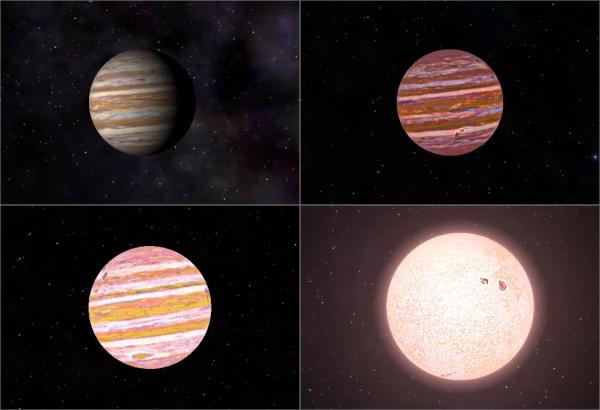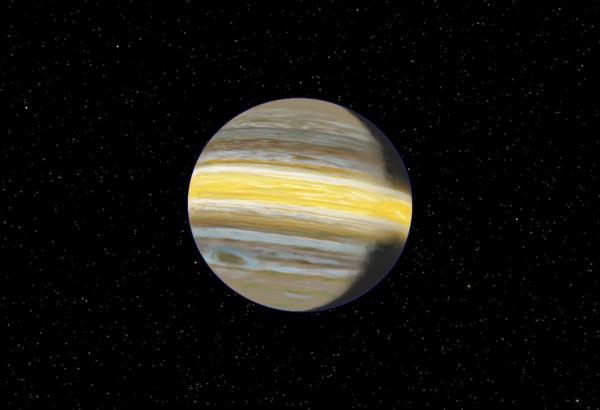BY LETTER
Stellification Engine
Technology > Application > Infrastructure
Technology > Application > Megascale Engineering
Technology > Application > Power Generation
Technology > Technology Levels > Ultratech
Technology > Application > Megascale Engineering
Technology > Application > Power Generation
Technology > Technology Levels > Ultratech
Class of macroengineering devices designed to convert white dwarf, jovian, or brown dwarf class bodies into radiant, star-like objects.
 Image from Steve Bowers | |
| A jovian class world stellified by magmatter conversion gradually increases in diameter as its temperature increases | |
Stellification engines are usually used in the reconstruction of jovian or brown dwarf moon systems as an aid to terraforming or other development. More rarely they may be used to "reignite" white dwarf stars. The basic principles of using an engine are very simple. The device or devices are introduced into a body and, after a period of time, cause it to radiate light and heat equivalent to a small star.
This in turn allows a number of options for the development of the local planet, moon, or ring systems, ranging from terraformation, to the creation of habitat swarms, to conversion into a Matrioshka micro-node processing substrate.
Types of Stellification Engines
Stellification engines come in a number of different types.Micro-Singularity
A small, artificial black hole, usually massing about as much as the dwarf planet Ceres (pre-development mass: ~9E20kg) in the Sol system, is introduced into the body. After a period of time (usually about a century) spent orbiting back and forth inside the interior, the singularity comes more or less to rest in the center of the body where it begins to consume its mass. As material falls into the hole, it is heated to immense temperatures and large amounts of energy radiate outward.The radiation and particle pressure from this process balances the infall of core material until steady-state equilibrium is achieved. Enough material falls into the hole to keep the process going, but the radiant energy produced limits the amount of infalling material to a fairly constant level. As the energy from the processes radiates outward, the star, jovian, or brown dwarf begins to glow and radiate heat into the surrounding space, providing both illumination and warmth for future development. As the black hole consumes more and more of the core the process of consumption and energy output accelerates until eventually (tens or hundreds of millions of years later) the radiant energy produced exceeds safe levels and stellar disassembly techniques must be used to halt the process and extract the singularity, whether to be used in another artificial star or for some other purpose.
Micro-singularity based stellification is both the oldest and least used of the methods available. Dating to the Information Age in its conception (by researcher Martyn J. Fogg) and first attempted during the late First Federation period, the technology is the only one of the methods available that lends itself entirely to modosophont levels of achievement. At the same time, issues of cost, safety, and long-term environmental impact have caused all but the most ardent hu-supremacists to seek other, safer options.
Of the twenty-three known instances of micro-singularity based stellification that have been attempted, four were abandoned before injection of the singularity into the target body (either due to cost overruns or because it was decided to use the singularity elsewhere), five resulted in higher levels of illumination or faster illumination increase than anticipated, requiring major modification of the project plan (up to and including early evacuation of the population), seven resulted in a runaway core collapse into the singularity, causing severe damage to or destruction of the local civilization (cf. Entadi's Star, Terra Nova historical database, NoCoZo, 3455AT), and seven continue in use to this day (although negative publicity from the difficulties experienced by other projects has virtually guaranteed that all seven locations host far smaller populations than the original developers anticipated or might have wished).
Neumann Reactor
One or more self-replicating alchemic reactors are introduced into the upper atmosphere of the target jovian or brown dwarf. Self-replicating technology of this type (also known as Neumann tech) will increase in number rapidly given a suitable environment, but Neumann-reactor type stellification does not lend itself to the stellification of white dwarfs.Supported by a vacuum dirigible, each reactor uses CNO-cycle fusion and particle synthesis to consume the surrounding atmosphere and convert it into energy and raw materials. The energy produced is released upward as light from a large directional radiator complex on the top of each unit, while the materials are used to build another reactor. Each reactor generally takes about a standard year to replicate, after which the "child" reactor is released to begin its own process of atmospheric consumption and replication while the "parent" unit begins the process again. As the number of reactors increases exponentially, they position themselves in large, meta-stable arrays or "flocks" which optimize material intake while leaving sufficient spacing for safe waste energy outflow.
Although each individual reactor remains widely separated from its fellow's even when maximum deployment is achieved, over orbital distances the massed devices present a virtually continuous field of brilliant illumination (the lowest orbiting moons or habitats may experience a certain amount of "granularity" in the illumination they receive but this is generally just ignored or dealt with using appropriately designed lenses in the habitats mirror and window installations).
Operating at full efficiency, the offspring of a single Neumann reactor can replicate to maximum safe coverage of the entire surface of a standard jovian or brown dwarf in less than a century. In practice, the timescales involved are often much shorter since many users prefer to only illuminate those orbits they plan to inhabit rather than the entire surrounding volume and limit the spread of the reactors accordingly. A common design methodology is the "Sunline", in which reactors are deployed only around the equator of the central body and are used to illuminate the orbits of the surrounding moons, rings, and habitats.
 Image from Steve Bowers | |
| A Class 1 sunline | |
Neumann reactors were initially a First Singularity technology, created by the ahuman AIs who fled the Solar System before the Technocalypse. As the telescopic surveys and exploration swarms of the early Federation expanded out into space, they occasionally encountered gas giants or brown dwarfs that had been re-engineered using the technology and then abandoned. While few, if any, of these early sites were created for the purpose of supporting biological life, the potential of the technology was obvious to all. Although First Federation hyperturings were easily able to reverse engineer the technology, an arguably more momentous development was the discovery by a Deeper Covenant exploration tribe that their software protocols were compatible with the control systems of the Neumann reactors they were studying at the brown dwarf Taniff'a (Inner Sphere NoCoZo).
After almost five years of effort they were able to reliably interface with and apply simple control signals to the Neumann's operating systems, allowing them to direct and "herd" the reactors in at least a basic way. The impact of this discovery can be seen even into the Current Era, with the majority of Neumann reactors in use today being descended from the "Taniff'a line".
While later millennia would see modosophonts also develop Neumann reactor technology, their attempts were (and continue to be) far less efficient, flexible, and generally capable than the products of transapient technology. As such, the majority of users continue to prefer to use "naturally grown" Neumann reactors whenever possible. Seeala g'o Etal, the head of the Deeper research team that first learned to control the reactors at Taniff'a perhaps said it best in eir autobiography Taming Fire 2.0 (1475AT). Eir words are still as true now as they were when e first said them: "It's a lot easier to milk the cow than it is to make the cow".
It is perhaps one of history's little ironies that most historians agree that g'o Etal had probably never actually ever seen a cow at the time e said this.
Magmatter Conversion Frame
The most advanced class of stellification engine, the magmatter conversion frame is the product of Third Singularity or higher minds. As its name implies, a conversion frame is constructed entirely of magmatter and magnetic monopoles and as such is both very small and very massive. What is perhaps the most singular aspect of the construct however, is its shape. A conversion frame is constructed in the form of a fractally repeating pattern of planes and control elements extending outward in three dimensions. The resulting shape is most often compared to that of the most complex blooming plants and has led to the nickname of this device: the Sunflower.When deployed into the interior of a white dwarf, jovian, or brown dwarf, a conversion frame at first operates much like a singularity-based stellification engine. As matter comes into contact with the frame, it is channeled into millions of microscopic conversion reactors coating the structure's surfaces and converted into energy which radiates outward, causing the frame to glow at stellar intensity levels and converting much of the surrounding planetary material to plasma. However, rather than being purely at the mercy of gravitational and orbital forces as it moves into the interior of the target body, a conversion frame is able to descend in a controlled manner. By opening and closing the many "petals" that make up its structure it can alter its surface area and to some degree the amount and direction of the reactions it catalyzes in the surrounding environment. In this manner it is able to reach the center of the target body in a matter of hours or days rather than the years normally associated with a singularity type engine.
Once it reaches its destination at the core, the conversion frame continues to operate as a smart structure, continually monitoring the planetary core and altering its shape to ensure an optimized `pseudo-stellar' environment. In this way it eliminates the flares or core destabilization events that occasionally plague singularity type stellification technologies. At its most advanced, a conversion frame can provide "real-time" control of its operation, communicating with the outside world via modulated neutrino beams. Using this method it is possible, in only a matter of a few centuries, to "turn down" the stellified body to the point it is barely shining or "turn it up" to the point where it is several times brighter than a normal star. The latter technique is usually employed only for major industrial operations up to the disassembly of the entire mass.
While many methodologies exist for the development of jovians, white dwarf, or brown dwarf type bodies across the Civilized Galaxy, full or partial stellification is a popular option with many polities and civilizations. In particular the Deeper Covenant, Solar Dominion, and NoCoZo are known for making extensive use of the technology.
Related Articles
- Artisuns
- Brown Dwarf
- Gayomart Protectorate, The
- Jovian Class
- Matrioshka Micronode
- Starbooster
- Stellar Engineering - Text by M. Alan Kazlev
Modifying or customizing a star in any manner. Could be for the purposes of stellar husbandry, or for more exotic purposes. - Stellar Husbandry
- Sunline
- White Dwarf
Appears in Topics
Development Notes
Text by Todd Drashner and Luke Campbell
Initially published on 29 June 2009.
Initially published on 29 June 2009.






